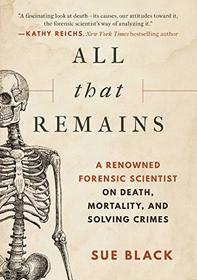Sue Black is a Scottish forensic anthropologist well-recognized for her work in the field, the dissecting room, and the classroom. She has done groundbreaking work in research on "reading" veins for identification purposes, written a textbook to provide investigators with information about the human body's growth at all stages of life, pushed for the adoption of official Disaster Victim Identification programs, and guided the implementation of the Thiel method of embalming (with its many benefits over earlier methods about which the reader will learn). She should also be lauded for her writing, as _All that Remains_ is a sort-of memoir-plus-intriguing examination of mortality and the, surprisingly, many offshoots of it.
Black begins with her family history, growing up in a butcher's shop and then dissecting cadaver "Henry" in the University of Aberdeen dissecting room. She also tells of her devotion to her Uncle Willie and the emotional impact of his demise and the deaths of her parents.
The book frequently segues from the story of Black's life into scientific, procedural, and criminal discussions related to death. For instance, the reader learns of the seven stages of "postmortem alteration" - an explanation of a human body's decay over time. Black writes of post-death options: burial, cremation, and donating one's body to science for education (her urging for others and her desire for her own corpse). The reader learns how investigators determine the age and gender of bodies from their skeletal remains. The author sprinkles the text with interesting facts, such as the following: tattoo dye eventually leaches into lymph nodes, so coloration in armpits can also be an identifying factor when human bones are found.
Black also tells the stories of famous cases with which she has been involved, some successful and some still unsolved. One involved digging up layers of coffins in the hunt for a missing person. No spoiler alert here! She describes the humanitarian efforts she has assisted with as a forensic anthropologist in the Kosovo genocide and after the recent Thailand tsunami. She even devotes a long passage to dismemberment: motivations for dismembering a body, how it's done, and the special challenges it poses for forensic anthropologists and investigators.
Near the end, Black explains how she is able to do a job that others view as deeply disturbing and also be a loving wife and mother; she describes these realms of her existence as "rooms" to which only she has the keys.
_All that Remains_ largely, and somewhat oddly, avoids contemplation of an afterlife. Black calmly and straightforwardly views death as female and as the end of a human's existence. A reader may wonder about the brevity of Black's conclusions and the reason for it.
(Quick note for American readers: The reader may have to look up various English and Scottish slang and phrases sprinkled throughout the book. The differences between American and British policies are a compelling aspect of _All that Remains_, too.)
A really interesting read about a really interesting woman in a field that few people talk about!
Black begins with her family history, growing up in a butcher's shop and then dissecting cadaver "Henry" in the University of Aberdeen dissecting room. She also tells of her devotion to her Uncle Willie and the emotional impact of his demise and the deaths of her parents.
The book frequently segues from the story of Black's life into scientific, procedural, and criminal discussions related to death. For instance, the reader learns of the seven stages of "postmortem alteration" - an explanation of a human body's decay over time. Black writes of post-death options: burial, cremation, and donating one's body to science for education (her urging for others and her desire for her own corpse). The reader learns how investigators determine the age and gender of bodies from their skeletal remains. The author sprinkles the text with interesting facts, such as the following: tattoo dye eventually leaches into lymph nodes, so coloration in armpits can also be an identifying factor when human bones are found.
Black also tells the stories of famous cases with which she has been involved, some successful and some still unsolved. One involved digging up layers of coffins in the hunt for a missing person. No spoiler alert here! She describes the humanitarian efforts she has assisted with as a forensic anthropologist in the Kosovo genocide and after the recent Thailand tsunami. She even devotes a long passage to dismemberment: motivations for dismembering a body, how it's done, and the special challenges it poses for forensic anthropologists and investigators.
Near the end, Black explains how she is able to do a job that others view as deeply disturbing and also be a loving wife and mother; she describes these realms of her existence as "rooms" to which only she has the keys.
_All that Remains_ largely, and somewhat oddly, avoids contemplation of an afterlife. Black calmly and straightforwardly views death as female and as the end of a human's existence. A reader may wonder about the brevity of Black's conclusions and the reason for it.
(Quick note for American readers: The reader may have to look up various English and Scottish slang and phrases sprinkled throughout the book. The differences between American and British policies are a compelling aspect of _All that Remains_, too.)
A really interesting read about a really interesting woman in a field that few people talk about!




